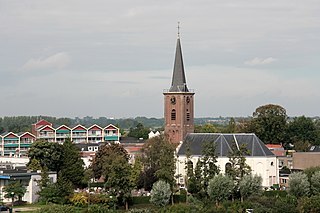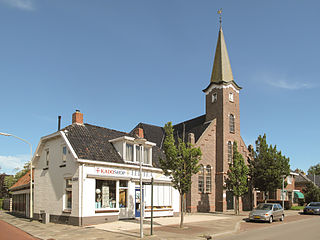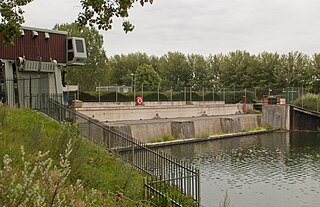
Demographic features of the population of the Netherlands include population density, ethnicity, education level, health of the population, economic status, religious affiliations and other aspects of the population.

Kapelle is a municipality and a town in the southwestern Netherlands on Zuid-Beveland. In 2023 the municipality's population amounts to 13,051.

Rozendaal is a municipality and a town in the eastern Netherlands, in the province of Gelderland. The town, next to Arnhem and Velp, is known for the Rozendaal Castle and its water fountain follies (bedriegertjes).

Aldtsjerk is a village on the main road from Leeuwarden to Dokkum. It is part of Tytsjerksteradiel municipality, Friesland, the Netherlands and had around 615 inhabitants as of January 2018.

Mijdrecht is a town in the Netherlands with about 16,000 residents. It is located in the municipality of De Ronde Venen, about 7 kilometres (4.3 mi) west of the main A2 motorway, between Utrecht and Amsterdam.
Allochtoon is a Dutch word (from Greek: ἀλλόχθων, from ἄλλος allos'other' and χθών chthōn'soil, earth, land', literally meaning "emerging from another soil". It is the opposite of the word autochtoon (in English "autochthonous" or "autochthon"; from Greek αὐτόχθων, from αὐτός autos'self, same' and again χθών chthōn'soil, earth, land', literally meaning "emerging from this soil".

Driemond is a village in the Dutch province of North Holland. It is a part of Weesp, an Urban area in the municipality of Amsterdam, Netherlands.

Gnephoek is a polder and a hamlet in the Dutch province of South Holland. It is a part of the municipality of Alphen aan den Rijn, and lies about 2 km west of Alphen aan den Rijn.

Gerd Arntz was a German Modernist artist renowned for his black and white woodcuts. A core member of the Cologne Progressives, he was also a council communist. The Cologne Progressives participated in the revolutionary unions AAUD (KAPD) and its offshoot the AAUE in the 1920s. In 1928 Arntz contributed prints to the AAUE paper Die Proletarische Revolution, calling for workers to abandon parliament and form and participate in worker's councils. These woodcut prints feature recurring themes of class.

Aduard is a village in the municipality of Westerkwartier, in the Netherlands. It is located about 8 km northwest of Groningen. As of 1 January 2023, it had a population of 2,095.

Munstergeleen is a village in the Dutch province of Limburg. It is located in the municipality of Sittard-Geleen, and it lies in the Western Mine Region.

Westmaas is a village in the Dutch province of South Holland. It is located about 14 km south of the city of Rotterdam, next to Mijnsheerenland in the municipality of Hoeksche Waard. In 2020, the population was 2,065.
Koreans in the Netherlands form one of the smaller Korean diaspora groups in Europe. As of 2022, 9,469 people of Korean origin lived in the Netherlands.
Vietnamese people in the Netherlands form one of the smaller overseas Vietnamese communities of Europe. They consist largely of refugees from the former South Vietnam, Vietnamese born-citizens and their descendants.
There is a small population of Angolans in the Netherlands numbering around 10,000 people, largely consisting of refugees from the Angolan Civil War.

There is a small community of Nigerians in the Netherlands, which began to grow in the late 1980s.

Despite its long interaction with water, the Netherlands has little potential for hydropower due to its flat topography. The Netherlands has a large resource of moving water in its major rivers but its limited hydraulic head because of little elevation change means that hydropower is a minor component of the country's renewable energy portfolio. A few small hydro plants exist but in total produce less than one tenth of one percent (<0.1%) of the Netherlands' electricity.

Philippus Jacobus Idenburg was a Dutch educationalist and statistician.
Hongkongers in the Netherlands are people in the Netherlands originated from Hong Kong or having at least once such parent.

Charles Hubert Eyck was a Dutch visual artist. Together with Henri Jonas and Joep Nicolas, he was a pioneer of the Limburg School.
















